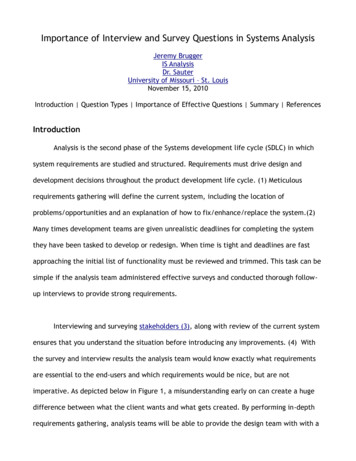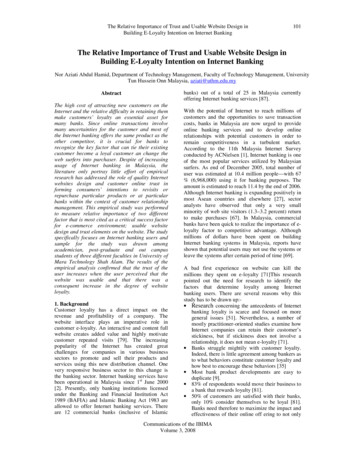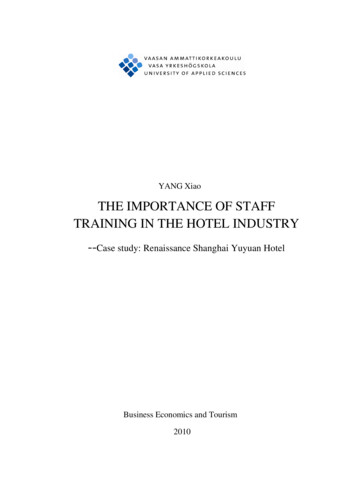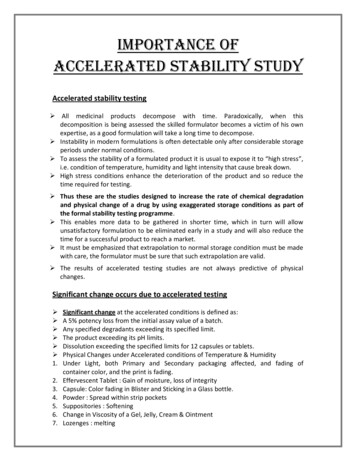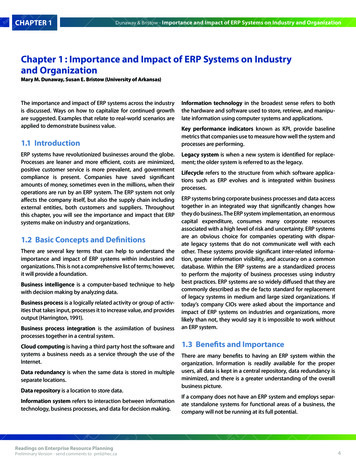
Transcription
DBR410Acc.Pay.CFacpr toryod ouc uttio pun tCRRevenueDBpr Ma COod ss 4uc re 1tio lean seorderDBRm RawateriaC lCRFipr nishoDB d eductsCRPuto roDB utp d.Prodor uctde ior nCRCRInvch enDB an torge yMary M. Dunaway, Susan E. Bristow (University of Arkansas)Mprod Re D0luc e a 7tio seDBCCRoDB raw ns.DBFipr nisod heuc dtChapter 1 : Importance and Impact of ERP Systems on Industryand OrganizationInformation technology in the broadest sense refers to boththe hardware and software used to store, retrieve, and manipulate information using computer systems and applications.141CRDB30Legacy system is when a new system is identified for replacement; the older system is referred to as the legacy.Lifecycle refers to the structure from which software applications such as ERP evolves and is integrated within businessprocesses.ERP systems bring corporate business processes and data accesstogether in an integrated way that significantly changes howthey do business. The ERP system implementation, an enormouscapital expenditure, consumes many corporate resourcesassociated with a high level of risk and uncertainty. ERP systemsare an obvious choice for companies operating with disparate legacy systems that do not communicate well with eachother. These systems provide significant inter-related information, greater information visibility, and accuracy on a commondatabase. Within the ERP systems are a standardized processto perform the majority of business processes using industrybest practices. ERP systems are so widely diffused that they arecommonly described as the de facto standard for replacementof legacy systems in medium and large sized organizations. Iftoday’s company CIOs were asked about the importance andimpact of ERP systems on industries and organizations, morelikely than not, they would say it is impossible to work withoutan ERP system.Mpu Co E5rc nv 9Nha erse t toorderEx Mec Dut 01eMRPERP systems have revolutionized businesses around the globe.Processes are leaner and more efficient, costs are minimized,positive customer service is more prevalent, and governmentcompliance is present. Companies have saved significantamounts of money, sometimes even in the millions, when theiroperations are run by an ERP system. The ERP system not onlyaffects the company itself, but also the supply chain includingexternal entities, both customers and suppliers. Throughoutthis chapter, you will see the importance and impact that ERPsystems make on industry and organizations.5Cpr Con O15od fiuc r mtionInre depqu eire ndm enen ttPuror chade serThere are several key terms that can help to understand theimportance and impact of ERP systems within industries andorganizations. This is not a comprehensive list of terms; however,it will provide a foundation.Po Ms IGre t go Oce oip dstsBusiness intelligence is a computer-based technique to helpwith decision making by analyzing data.51.2 Basic Concepts and Definitions401.1 IntroductionKey performance indicators known as KPI, provide baselinemetrics that companies use to measure how well the system andprocesses are performing.CRCrea VLte 01de NliveryInvestDBments413CashThe importance and impact of ERP systems across the industryis discussed. Ways on how to capitalize for continued growthare suggested. Examples that relate to real-world scenarios areapplied to demonstrate business value.40CR40Po Mst IROinvoiceDBIf a company does not have an ERP system and employs separate standalone systems for functional areas of a business, thecompany will not be running at its full potential.PosCRBCRCaspututnnuesPreliminary Version - send comments to pml@hec.cahInvesReadings on Enterprise Resource PlanningtmentsDBGR/IRDBInveso ntold rypr chod anuc getInformation system refers to interaction between informationtechnology, business processes, and data for decision making.RRco awns mum atept riaio lnData repository is a location to store data.There are many benefits to having an ERP system within theorganization. Information is readily available for the properusers, all data is kept in a central repository, data redundancy isminimized, and there is a greater understanding of the overallbusiness picture.Acc.Pay.Csa Dole mre esve ticnuesDBData redundancy is when the same data is stored in multipleseparate locations.1.3 Benefits and ImportanceGRCRRawmatCloud computing is having a third party host the software andsystems a business needs as a service through the use of theInternet./IRBusiness process integration is the assimilation of businessprocesses together in a central system.6GoodsreceiptBusiness process is a logically related activity or group of activities that takes input, processes it to increase value, and providesoutput (Harrington, 1991).t p F-53aymenec.Dunaway & Bristow - Importance and Impact of ERP Systems on Industry and OrganizationDBCRAcc.RCHAPTER 14
DBR410Acc.Pay.CFacpr toryod ouc uttio pun tCRRevenueDBDBProdor uctde ior n411Mprod Re D0luc e a 7tio sepr Ma COod ss 4uc re 1tio lean seorderRCCRCashDB5Cpr Con O15od fiuc r mtion40t p F-53aymenPosR40Po Mst IROinvoiceCRAcc.Pay.CCRDBGR/IRbeen able to answer all the questions posed by the customerinstead of having to transfer the customer from department todepartment. All of the information is shifted from functional areas to the front-line, or in other words, to the person thecustomer will first contact when communicating with thecompany. From the above illustration, the importance of thecorrect employees having the correct information (in this casethe customer service representative), is crucial to deliveringexceptional customer service, and in turn serving the customerin the most valuable way.CRBCRCaspututnnuesPreliminary Version - send comments to pml@hec.cahInvesReadings on Enterprise Resource PlanningtmentsDBGR/IRDBInveso ntold rypr chod anuc getRco awns mum atept riaio lnsa Dole mre esve ticnuesDBRawmatWith this illustration, the cycle has come full circle; back tothe original starting point. How much easier would it havebeen for the customer if the customer service representativehad the answers to every question that the customer asked ?One of the most significant features of an ERP system is thatall of the information kept by a company, including withinfunctional areas, is retained in one central data repository, or inother words, the information is saved in a single database. Byhaving the information in one location with authority levels foraccess in place, a customer service representative would have6GoodsreceiptPo Ms IGre t go Oce oip dstsInre depqu eire ndm enen tt405Puror chade serMpu Co E5rc nv 9Nha erse t toorderEx Mec Dut 01eMRP30entsCRInvestDBmCRoDB raw ns.CRDBCRInvch enDB an torge y413Crea VLte 01de NliveryWhen a customer calls to inquire about an order, the customermay be bounced around to numerous departments within thecompany because the customer service representative does nothave all the answers at his or her fingertips. Here is an illustrationof this type of scenario produced by Hammer and Company.DBFipr nisod heuc dtData may be compromised because it is stored in multiplelocations. How would a user know which information is mostcurrent ? When data is changed, is there a guarantee that it willbe updated in all storage locations ? Are processes taking longerto start and finish than necessary ?m RawateriaC lCRFipr nishoDB d eductsCRPuto roDB utp d.ec.Dunaway & Bristow - Importance and Impact of ERP Systems on Industry and OrganizationDBCRAcc.RCHAPTER 15
DBR410Acc.Pay.CFacpr toryod ouc uttio pun tCRRevenueDBDBProdor uctde ior nMprod Re D0luc e a 7tio sepr Ma COod ss 4uc re 1tio lean seorderRC141 Increase in organizational flexibility5Cpr Con O15od fiuc r mtion30CashCR Improved security and availabilityDBentsFuβ et al., (2007) have researched multiple articles and developeda list of anticipated benefits of ERP systems. The list includes thefollowing benefits (p. 159) :CRInvestDBm Cost reduction Fast amortization of investment More efficient business processes Higher quality of business processes Improved integrability Reduced complexity and better harmonization of IT infrastructure Better information transparency and quality Better and faster compliance with legal requirements andframeworksBagranoff and Brewer (2003) wrote a case study based on a realcompany’s ERP implementation. The authors use a fictitiouscompany name, PMB Investments, Inc., to protect the confidentiality of the real company. The company’s Amscot division,located outside of Little Rock, Arkansas, was in charge of printing, assembling, and distributing all printed materials for internal and external customers interested in the company’s financialservices and investments. The Amscot office was created as aresult of anticipated growth. Amscot began with a hand-medown legacy system named OSCAR, which came from theclosing of two other plants to form the new Amscot plant.Unfortunately, OSCAR could not handle the increased volumeof transactions. The ability to deliver to Amscot’s customerswas compromised. A second system was connected to OSCARnamed KIM to help relieve the stress of the growth. “However,once every few weeks the interface between KIM and OSCARwould go down between 12 to 18 hours resulting in customer orders literally disappearing into cyberspace somewherebetween KIM and OSCAR” (p. 86). Occasionally employees wouldperform a manual count of warehouse inventory because theydid not trust reports produced by OSCAR, resulting in inventorybeing managed in multiple locations.5t406Goodsreceipt p F-53aymenCRBCRCaspututnnuesPreliminary Version - send comments to pml@hec.cahInvesReadings on Enterprise Resource PlanningtmentsDBGR/IRDBPosRAcc.Pay.C40Po Mst IROinvoiceCR/IRDBGRatCRmRawDBInveso ntold rypr chod anuc getRco awns mum atept riaio lnsa Dole mre esve ticnues40Po Ms IGre t go Oce oip dstsInre depqu eire ndm enen ttAn ERP system allows users and the company to formulatea better understanding of the overall business picture. Withaccess to multiple functional areas in one system, and the abilityto generate any report necessary, the benefits of an ERP systemare endless. Management and executives can formulate betterbusiness decisions because of all the data readily availablewithin the system. Business performance can improve since theERP system integrates business processes, that traverse multiplebusiness functions, divisions, and geographical locations(Ranganathan et al., 2006). Another benefit of ERP systems istheir ability to manage potential growth within the companyand future e-commerce and e-supply chain investments. ITcosts can be significantly reduced when implementing an ERPsystem (Fuβ, Gmeiner, Schiereck, & Strahringer, 2007). For thebanking industry, merging banks can shorten post-mergerintegration time by 12 to 18 months, with a cost savings ofpotentially 60 to 80 million. Also, ERP systems can assist bankswith the continuous industry-specific pressures, such as governmental regulations and globalization, faced by the bankingindustry. ERP systems can help a global bank run smoothly andadhere to compliance. The construction industry faces their ownchallenges when implementing ERP (Chung, Skibniewski, Lucas& Kwak, 2008). Their industry processes are less standardizedPuror chade serMpu Co E5rc nv 9Nha erse t toorderEx Mec Dut 01eMRPCRoDB raw ns.CRDBCRInvch enDB an torge y413Crea VLte 01de Nliverywhen compared to manufacturing. For example, each construction project has a unique owner, project team, and specifications. When an ERP system is implemented successfully in theconstruction industry, Chung et al., (2008) report benefits ofimproved efficiency, and evident waste elimination.DBFipr nisod heuc dtThe central repository of information will allow authorized usersto access the same information in one location using an ERPsystem. This feature allows for one version of information to beused. With the central data repository comes the decline of dataredundancy. The data is kept in one location where all authorized users have access. Data redundancy occurs when the samedata is placed in two or more separate systems (Shelly, Cashman,& Rosenblatt, 2005). For example, referring back to our illustration before, the customer needed to change the ship to address.If the company maintained separate functional area systems,the customer’s ship-to address would have had to be updatedin all the places it was stored. Potential for human error becomesa factor at this point. The employee could miss a locationwhere the customer’s ship-to address needed to be changed,or the employee could have mistyped the correct informationin any one of the change points. Having one central place forthe information to be stored reduces the likelihood of humanerror and not using the correct information for future transactions. Ranganathan and Brown (2006) suggest that the use ofa centralized data repository in an ERP system will result “in anintegrated database for multiple functions and business units,providing management with direct access to real-time information at the business process, business division, and enterpriselevels” (p. 146).m RawateriaC lCRFipr nishoDB d eductsCRPuto roDB utp d.ec.Dunaway & Bristow - Importance and Impact of ERP Systems on Industry and OrganizationDBCRAcc.RCHAPTER 16
DBR410Acc.Pay.CFacpr toryod ouc uttio pun tCRRevenueDB1Mprod Re D0luc e a 7tio sepr Ma COod ss 4uc re 1tio lean seorderDBR41CR5Cpr Con O15od fiuc r mtion30CashDBentsInvestDBmCR1.4.2 Business Value of ERP SystemsNot only is IT value prevalent in ERP systems, but there is soundbusiness value as well. For example, an ERP human capitalmanagement (HCM) system can help align a company’s businessstrategy. This provides integrated processes and reporting, themanaging of workforce to place the right people in the rightjobs, develop and reward top performers, retain key talent forthe long term, and increase efficiency and operating performance throughout the entire organization. An HCM ERP providessubstantial benefit to a company while delivering a blueprint fortransforming a company’s human resource operations. Thesetypes of ERP systems make it possible to rapidly experiencereturn on investment through reduced operation costs andincreased efficiency. The HCM ERP system connects employees1.4 Value of ERP SystemsGetting the most out of IT is not a one-shot effort, but rathera continuous and evolving process. Included is not just the ITinvestment, but also how a company approaches improvementopportunities in support of its business strategy and objectives,business processes, and value assessments.Mpu Co E5rc nv 9Nha erse t toorderEx Mec Dut 01eMRPCRProdor uctde ior nDBCCRoDB raw ns.Research has demonstrated a circular cycle where one IT successgives rise to yet another IT success more favorable than thefirst (sometimes referred to as the “virtuous cycle”). The cycletypically gets started with an investment in core ERP systemssoftware generating the landscape to facilitate a homogeneousintegrated platform. Once the core ERP software demonstratessound operational performance, investments to extend and addvalue to processes such as customer relationship management(CRM), supply chain management (SCM), and business analyticscomponents are examined.CRCore accounting and reporting capabilitiesPo Ms IGre t go Oce oip dstsInre depqu eire ndm enen ttFinancial supply chain managementCRBCRCaspututnnuesPreliminary Version - send comments to pml@hec.cahInvesReadings on Enterprise Resource PlanningtmentsDBGR/IRDBPosRAcc.Pay.CAnother important business functional area where ERP systemsprovide significant alignment for a company’s fiscal account-t p F-53aymenCRand management to deliver business processes and automatecommon administrative tasks, while leveraging industry bestpractices.40Po Mst IROinvoiceCRDBGRDynamic budgeting, forecasting and planningmRawDBInveso ntold rypr chod anuc getRco awns mum atept riaio lnsa Dole mre esve ticnues40Scalable shared servicesatWhen examining the value of ERP systems, investing in technology is only half of what is needed to realize its benefit. Accordingto SAP Executive Agenda, “investment in IT without analogousimprovements in the management practices around IT willlead only to a slight increase in productivity”. It is suggestedthat companies that invest in IT while enhancing managementpractices and governances have experienced sustainable resultsin increased value and improved productivity, in some instances6GoodsreceiptTreasury services/IR1.4.1 IT Value of ERP Systems5Puror chade serKPI is a tool that can be used to measure the ERP systems andprocess performance. Once an organization has defined itsoperational and strategic goals, progress can be measured. Thevalue of KPIs is a quantifiable measurement that reflects criticalsuccess factors of an organization. KPIs are established priorto the ERP implementation and will differ depending on theorganization. For example, a KPI could be defined to measurea) percentage of payable invoices that do not match a purchaseorder, b) accuracy of purchase orders that are received withoutdefect, complete, and on time, or c) elapsed time for orderapproval.40Invch enDB an torge y413Crea VLte 01de Nliveryas much as a 20% boost (Dorgan & Dowdy, 2004).DBFipr nisod heuc dtAmscot pursued the acquisition of an enterprise resourceplanning system to handle the circumstances the company wasfacing (Bagranoff et al., 2003). Amscot felt the long-run benefitsto having an ERP system would be the consolidation of financials,human resources, manufacturing, and distribution applicationsin one central database system. Additionally, Amscot believeddata redundancy and integrity problems regarding the multipleinformation systems would be eliminated. Decisions would bemade more efficiently and effectively because of real-time information generated from the ERP system. Fulfillment and deliverywould start automatically on receiving a customer order withthe new system. Having the entire supply chain coordinatedwould reduce printed material inventories, minimize unnecessary shipping expenses, and streamline the receiving of goodscycle time. The new system would allow Amscot to performand operate at peak efficiency. The ERP system implementationestimation of savings was 30 million annually, which came fromdiminishing the inventory obsolescence.m RawateriaC lCRFipr nishoDB d eductsCRPuto roDB utp d.ec.Dunaway & Bristow - Importance and Impact of ERP Systems on Industry and OrganizationDBCRAcc.RCHAPTER 17
DBR410Acc.Pay.CFacpr toryod ouc uttio pun tCRRevenueDBDBMprod Re D0luc e a 7tio sepr Ma COod ss 4uc re 1tio lean seorderProdor uctde ior n141305Cpr Con O15od fiuc r mtionFor a company’s financial supply chain, potential value canbe gained for improved cash flow, transparent and real-timebusiness intelligence, and reduced inventory levels, leading toshorter cash-to-cash cycle times, and increased inventory turnsacross the network that can lower overall costs. Companiescan potentially make significant gains to reduce overall financecosts, enabling greater collaboration with customers or suppliers, and streamlining operations to reduce costs and resourcedemands (adapted from SAP, Inc.).1.4.3 Business Process IntegrationCompanies realize the business value of ERP systems with theability to obtain business process integration. Business processintegration allows processes within a company to be incorporated together in one centralized system. The value of encompassing process integration permits companies to gain efficiencies inoverall and individual processes. Additionally, potential processimprovements may become visible.Companies can take advantage of an ERP financial system’sability to provide dynamic budgeting, forecasting, and planningto reduce overall financial costs. Financial ERPs offer companies the ability to streamline accounting, consolidation, processscheduling, workflow, and collaboration. By integrating budget,cost, and performance, companies can cap
mental regulations and globalization, faced by the banking industry. ERP systems can help a global bank run smoothly and adhere to compliance. The construction industry faces their own challenges when implementing ERP


